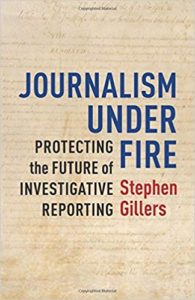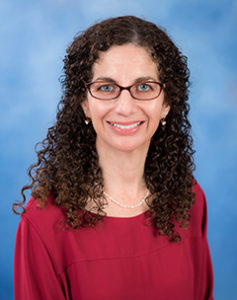Protecting the Future of Investigative Reporting
Book by Stephen Gillers
Reviewed by Carolyn Schurr Levin
For better or for worse, journalists became the story in 2018. In addition to being named as Time’s “Person of the Year,” journalists “taking great risks in pursuit of greater truths” were also honored by being called onto stage just before midnight to push the button that began the lowering of the Times Square New Year’s Eve ball, ushering in 2019. “In one of the world’s most famous public squares, it is fitting to celebrate free press and free speech as we reflect on where we’ve been during the past year and what it is we value most as a society,” said Tim Tompkins, president of the Times Square Alliance, the organizer of the New Year’s event.
 Although Americans may no longer agree on much, we can probably all agree that 2018 was a difficult year for journalists, and not only because the phrases “enemy of the people” and “fake news” were bantered around so often that they no longer jarred us. (Remember the days when we were all able to agree upon whether a fact was true or false?) Head shaking and hand wringing aside, what can–and should–be done to protect present and future journalists? In “Journalism Under Fire: Protecting the Future of Investigative Reporting,” Stephen Gillers, the Elihu Root Professor of Law at New York University Law School, answers that question, offering provocative, if perhaps wistful, solutions.
Although Americans may no longer agree on much, we can probably all agree that 2018 was a difficult year for journalists, and not only because the phrases “enemy of the people” and “fake news” were bantered around so often that they no longer jarred us. (Remember the days when we were all able to agree upon whether a fact was true or false?) Head shaking and hand wringing aside, what can–and should–be done to protect present and future journalists? In “Journalism Under Fire: Protecting the Future of Investigative Reporting,” Stephen Gillers, the Elihu Root Professor of Law at New York University Law School, answers that question, offering provocative, if perhaps wistful, solutions.
Gillers begins with two premises. First, a free press is essential to American democracy. Second, because the First Amendment, legislation, and court opinions are the primary sources of press freedom, the meaning of freedom of the press must begin with what the law says. Based upon these assumptions, he examines the First Amendment’s Press Clause through the framers’ intended meaning, textual analysis, and an intricate and detailed survey of the preeminent press cases (New York Times v. Sullivan, Branzburg v. Hayes, Cohen v. Cowles Media, and all of the other cases we teach in our media law classes). He argues that, although the Supreme Court has in recent decades ignored the Press Clause, the clause nonetheless gives a distinct set of rights to the press that the Constitution does not give to all speakers. Those rights are not static, but must change and expand as new circumstances arise. The press, Professor Gillers argues, needs protection against liability for defamation and privacy invasion, for the right to protect confidential sources without risking jail, and for how it gathers news.
The Press Clause has been eclipsed in Supreme Court case law by the Speech Clause, which provides rights to all speakers. Why? Perhaps it is because defining “the press” is tricky. Professor Gillers admits that defining the press “is indeed a challenge but hardly insurmountable.” He adamantly rejects the “well-intentioned but dangerous proposition” that we are all journalists now, writing that “[i]f, constitutionally, everyone can be the press, there is no press.” Press ethics, he believes, is what makes journalism a profession and “justifies the freedoms the Press Clause should be understood to guarantee and that legislation should expand.”
The press has, in fact, been defined multiple times outside the Supreme Court: in state shield laws, in the federal Freedom of Information Act, in proposed federal shield laws, in determining eligibility for press passes, and in lower federal court decisions. Gillers too offers a definition: The Press Clause should protect those “with the primary intent to investigate events or persons and to procure material in order to disseminate to the public news or information concerning matters of public interest.” It should not matter if the writer is affiliated with a news organization, as long as editorial judgment is exercised. Gillers’ definition of the press offers flexibility so that judges may “protect a larger group that might otherwise be excluded.”
In arguing for “a revival of the Press Clause,” Gillers focuses specific attention on the need to protect investigative reporting, which “is essential to the work of our democracy.” Again, a potential stumbling block is a workable definition. Gillers adopts and expands upon a definition offered by Richard Tofel, president of ProPublica, that investigative journalism is “journalism that seeks to reveal something that someone with a modicum of power (a person, group or institution) seeks to keep a secret.”
In addition to the judicial protections needed for investigative reporting, Gillers offers four legislative proposals to strengthen press protection. He argues for Congress to allocate public money for investigative reporting (like what the government does to build bridges, maintain parks, and fund libraries), to adopt a national anti-SLAPP law, to ensure the opportunity for appellate review of adverse jury decisions, and to strengthen and improve the federal Freedom of Information Act. This surely sounds like the wish list of many journalism professors.
Although Gillers began work on “Journalism Under Fire” in 2015, the 2016 election and subsequent efforts to weaken the press with allegations of fake news have given the book more urgency. They also led Professor Gillers to take a more aggressive stance to educate and provide ammunition to oppose those who would destroy the importance of the press.
In Professor Gillers’ analysis to strengthen press protections, the press has obligations too. In return for the protections afforded by the Press Clause, Gillers says, the press “must do its job in a manner that encourages our trust in the information.” This entails accuracy, completeness, fairness, independence, and the other high ethical standards that college media advisers instill in their students every day. Anyone can speak or write, but not all speakers and writers exercise editorial judgment, which is what entitles journalists to qualify for Press Clause protection. In a book filled with so much useful information for journalism professors, media advisers and students, this is perhaps the most helpful. Gillers makes clear that strengthening the fundamental protection for the press is far too important to be left only to lawyers or judges (“the questions here are too important to leave in the sole care of courts and lawyers,” he writes). Journalists and journalism students must be engaged and informed in order to lobby the public about the importance of the Press Clause.
Professor Gillers believes that the best way to contest efforts to weaken the press is for “the press to do its job professionally, one day at a time.” College media advisers and aspiring journalists are critical. Indeed, journalism and media studies students are in the target audience for Professor Gillers’ book. They “must labor to report the truth in the optimistic belief–obligatory even at the darkest moments–that doing so matters,” Gillers says. Attacks on the press “can be rebutted through persistence and good work.”
With his encyclopedic knowledge of the case law, Gillers offers a primer for students interested in a deeper dive into the cases they have encountered in their journalism classes. He acknowledges, however, that his proposals “would be ambitious in the best of times,” and that today they may be “fanciful.” So what? Far better to propose “fanciful” solutions to protect journalists than to continue to shake our heads and moan in disbelief. Or, as Professor Gillers says, if undergraduate journalism and media students absorb these lessons and are armed with the knowledge they need to demand that lawmakers protect them, we can begin to inch our way toward the protections that should be afforded by the Press Clause. It may be an uphill battle, but “hard victories begin with uphill battles.”

About the Author: Carolyn Schurr Levin, an attorney specializing in Media Law and the First Amendment, is a professor of journalism and the faculty adviser for the student newspaper at Long Island University, LIU Post. She is also a lecturer and the media law adviser for the Stony Brook University School of Journalism. She has practiced law for over 25 years, including as the Vice President and General Counsel of Newsday and the Vice President and General Counsel of Ziff Davis Media.
